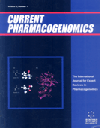- Home
- A-Z Publications
- Current Pharmacogenomics
- Previous Issues
- Volume 3, Issue 2, 2005
Current Pharmacogenomics - Volume 3, Issue 2, 2005
Volume 3, Issue 2, 2005
-
-
Genetic Diversity of Human SP-A, a Molecule with Innate host Defense and Surfactant-Related Functions; Characteristics, Primary Function, and Significance
More LessAuthors: Joanna Floros, Guirong Wang and Zhenwu LinPulmonary surfactant, a lipoprotein complex, is essential for life. It lowers the surface tension at the air-liquid interphase of the distal lung airspaces (alveoli) to prevent alveolar collapse at low lung volumes. Alveolar stability is critical in maintaining a normal O2/CO2 exchange. Surfactant deficiency in the prematurely born infant can lead to respiratory problems or respiratory distress syndrome (RDS); a major complication Read More
-
-
-
Innate Immunity and Intracellular Trafficking: Insights for Novel Anti- HIV-1 Therapeutics
More LessAuthors: Kate L. Jones and Johnson MakIt is now evident that host cells have evolved a remarkable variety of antiretroviral activities to defend themselves against viral invaders and in return viruses have developed ingenious ways to circumvent these defences and, in some cases, actually hijack cellular proteins in order to facilitate their replication. Study of this cat and mouse interplay between viruses and their host cells throughout evolution has lead to th Read More
-
-
-
Gene-Nutrient Interaction in Type 2 Diabetes: An Appraisal of the Role of the Peroxisome Proliferator-Activated Receptor Pathway
More LessAuthors: Tianhua Niu and Simin LiuType 2 diabetes mellitus (T2DM), characterized by insulin resistance and β-cell dysfunction, is a complex, multifactorial disease, which has become a worldwide epidemic in the 21st century. Twin and family studies have revealed a strong genetic component of T2DM, and a number of candidate genes such as the peroxisome proliferator-activated receptor γ (PPARγ) and CAPN10, have been identified in human populations. Previo Read More
-
-
-
Telomeres, Senescence and Longevity: The Role of Oxidative Stress and Antioxidants
More LessConsiderable evidence shows that accumulation of oxidative damage to various cellular macromolecules may be causally associated with cellular senescence and different age-related degenerative diseases. Telomeres are nucleoprotein structures that protect the ends of linear chromosomes. Telomeres in human somatic cells shorten with each cell division. The amount of shortening is largely dependent on the amount of oxida Read More
-
-
-
Pharmacogenetic Studies of Psychotropic Drug-Induced Adverse Effects
More LessAuthors: Shih-Jen Tsai and Chen-Jee HongPsychotropic drugs, like antipsychotics, antidepressants, mood stabilizers and anxiolytics, are effective for alleviation of certain psychiatric symptoms, however, the adverse-effects (AEs) associated with these psychotic medications may limit their use, and even cause serious outcomes. Individual differences in psychotropic-related AEs suggest that genetic components may play a major role. During the past 10-15 years, Read More
-
Most Read This Month
Article
content/journals/cpg
Journal
10
5
false
en


